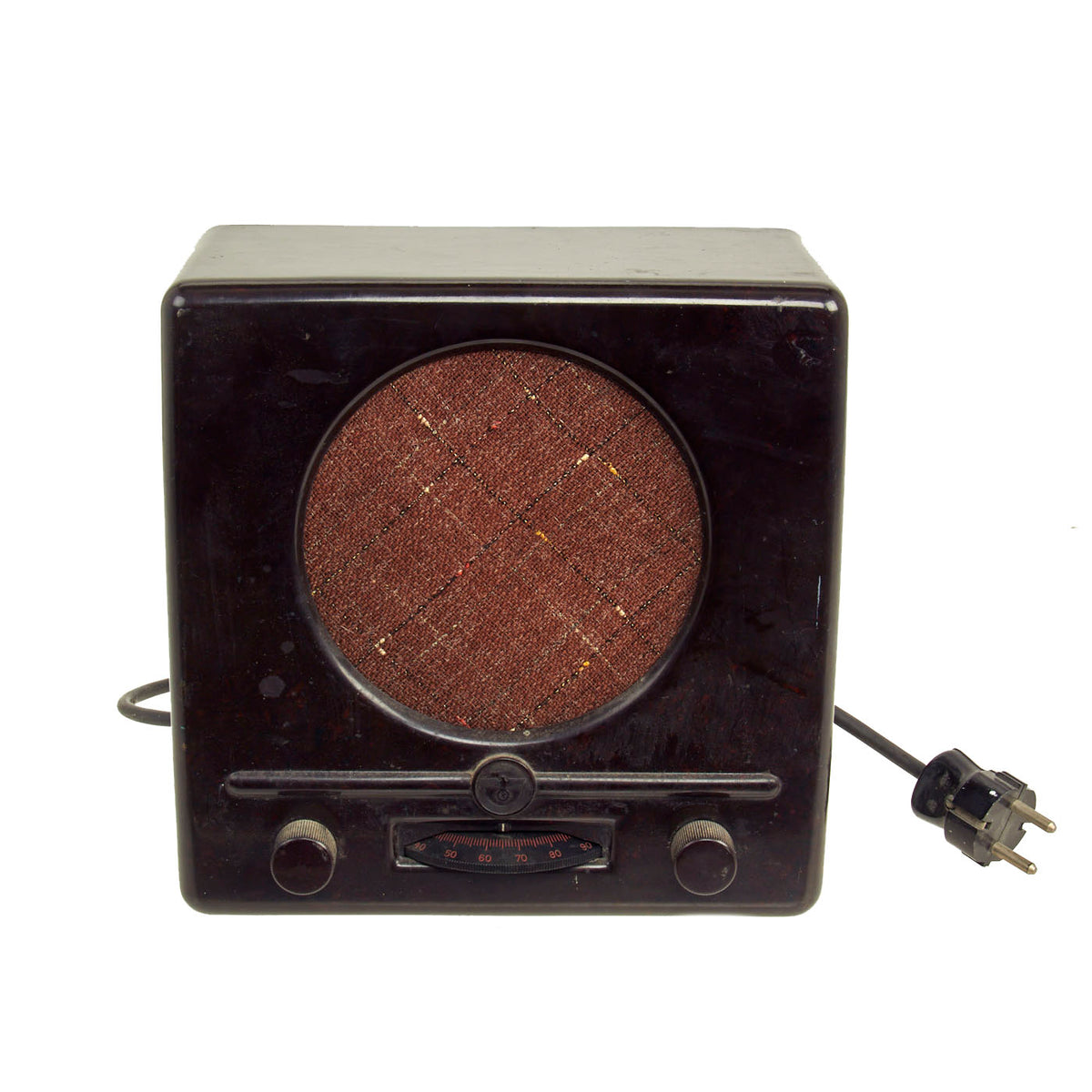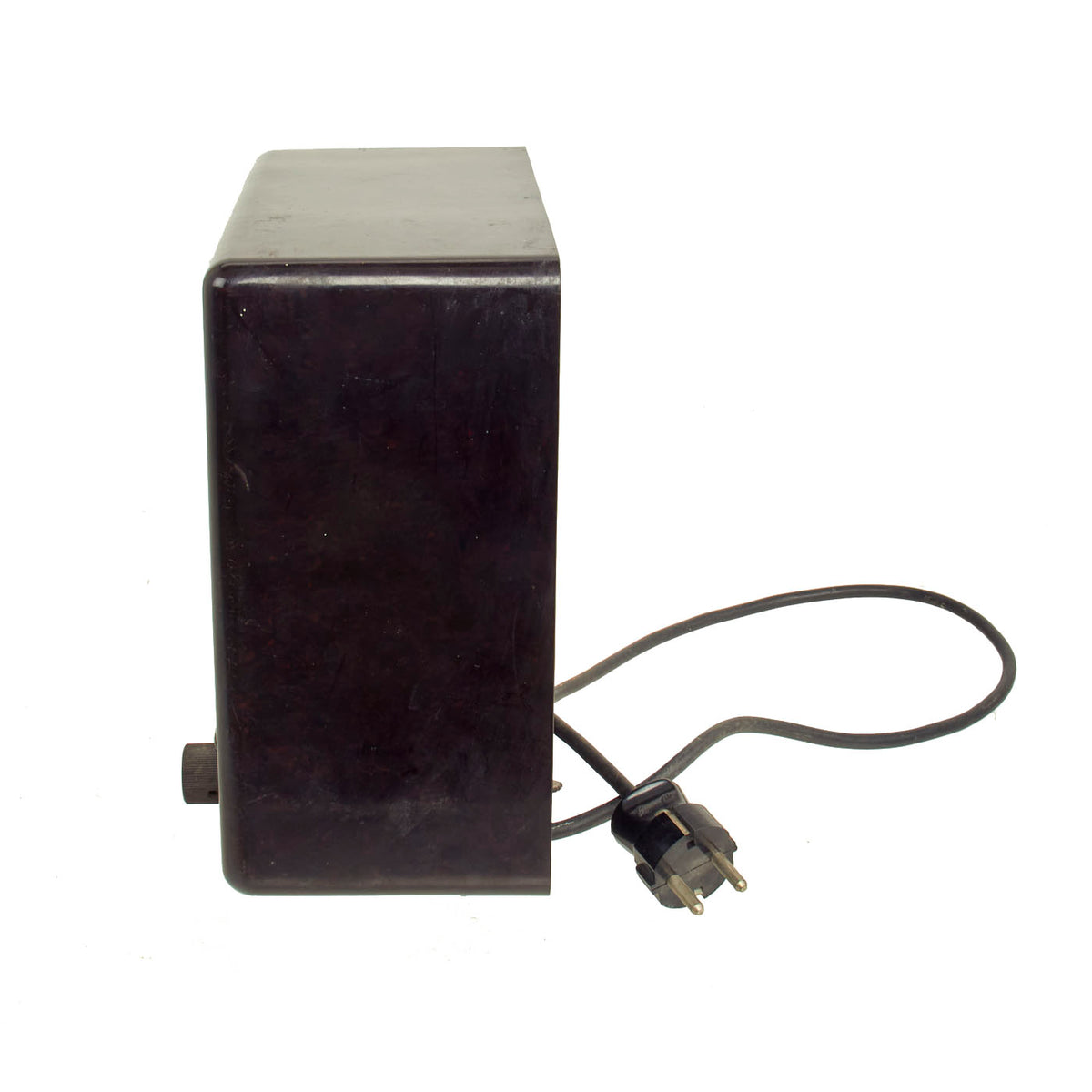Original German WWII 1938 Kleinempfänger DKE 38 Radio by Zerdik of Austria Original Items
$ 550,00 $ 165,00
Original Item: Only One Available. The Volksempfänger (“people’s receiver”) was a range of radio receivers developed by engineer Otto Griessing at the request of Propaganda Minister Joseph Goebbels. This example is the model DKE 38, and was manufactured by Deutsche Rundfunkempfängerfabrik (German Radio Receiver Factory) Zerdik in Austria.
The purpose of the Volksempfänger-program was to make radio reception technology affordable to the general public. Joseph Goebbels realized the great propaganda potential of this relatively new medium and thus considered widespread availability of receivers highly important.
The Volksempfänger was designed to be produced as cheaply as possible, as a consequence they generally lacked shortwave bands and did not follow the practice, common at the time, of marking the approximate dial positions of major European stations on its tuning scale. Only German and Austrian stations were marked and cheaper models only listed arbitrary numbers. Sensitivity was limited to reduce production costs further, so long as the set could receive Deutschlandsender and the local Reichssender it was considered sensitive enough, although foreign stations could be received after dark with an external antenna.particularly as stations such as the BBC European service increased transmission power during the course of the war.
Listening to foreign stations became a criminal offense in NSDAP Germany when the war began, while in some occupied territories, such as Poland, all radio listening by non-German citizens was outlawed (later in the war this prohibition was extended to a few other occupied countries coupled with mass seizures of radio sets). Penalties ranged from fines and confiscation of radios to, particularly later in the war, sentencing to a prison camp or capital punishment. Nevertheless, such clandestine listening was widespread in many NSDAP-occupied countries and (particularly later in the war) in Germany itself. The Germans also attempted radio jamming of some enemy stations with limited success.
This Deutscher Kleinempfaenger (more properly spelled Kleinempfänger) DKE 38 radio was first manufactured in 1938. The name means “German small radio.” The DKE in the model designation stands for the words Deutscher Kleinempfänger and the 38 signifies the year of introduction. Using only two tubes, it’s one of the simplest tube radios that you will ever come across. The Kleinempfänger was designed to be simple, and therefore cheap, so that as many Germans as possible could buy one. It cost only 35 Reichsmarks, roughly one week’s wages for an average worker of that day.
This was a propaganda radio, in short. Germans nicknamed this set Goebbels’ Schnauze (Goebbels’ snout), referring to the Minister of Public Enlightenment and Propaganda, whose voice was often heard over the airwaves. The appearance from the front is Spartan, a simple Bakelite box dominated by the circular speaker grille. This is a small radio, measuring about 9.5 inches square from the front, and only 4.5 inches deep. The controls consist of two knobs and a tuning dial marked with numeric scales from 0-100 in opposite directions. Directly above the dial you can see a tiny German eagle over a swas.
This nice example appears to be complete and appears to be in very good condition. It even retains the original cord and plug, which but we have not tried to test it. Both tubes are intact with intact getter flashes, so the vacuum is still good. The interior shows lots of Waffen proofs on various components. The speaker is missing two of the screws that secure it, and the back plate is missing one of the screws. It looks like some of the capacitors may have been replaced somewhat recently. There also some cracks in the outer bakelite housing, which has become brittle over the decades.
This is a rare chance to own an iconic piece of propaganda technology from AH’s Third Reich.
Fast Shipping with Professional Packaging
Thanks to our longstanding association with UPS FedEx DHL, and other major international carriers, we are able to provide a range of shipping options. Our warehouse staff is expertly trained and will wrap your products according to our exact and precise specifications. Prior to shipping, your goods will be thoroughly examined and securely secured. We ship to thousands clients each day across multiple countries. This shows how we're dedicated to be the largest retailer on the internet. Warehouses and distribution centres can be located throughout Europe as well as the USA.
Note: Orders with more than one item will be assigned a processing date depending on the item.
Before shipping before shipping, we'll conduct a thorough inspection of the items you have ordered. Today, the majority of orders will be delivered within 48 hours. The delivery time will be between 3-7 days.
Returns
The stock is dynamic and we cannot completely manage it because multiple stakeholders are involved, including our factory and warehouse. So the actual stock may alter at any time. It's possible that you may not receive your order once the order has been made.
Our policy is valid for a period of 30 days. If you don't receive the product within 30 days, we are not able to issue a refund or an exchange.
You can only return an item if it is unused and in the same state as the day you received it. You must have the item in its original packaging.
Related products
Uncategorized
Uncategorized
Armored Burgonet Helmet & Polearm from Scottish Castle Leith Hall Circa 1700 Original Items
Uncategorized
Uncategorized
Uncategorized
Uncategorized
Uncategorized
Uncategorized
Uncategorized
Uncategorized
Uncategorized
Uncategorized
Uncategorized
Uncategorized
Uncategorized
Uncategorized
Uncategorized
Armoured Fighting Vehicles of the World: AFVs of World War One (Hardcover Book) New Made Items
Uncategorized
Uncategorized
Uncategorized
Australian WWII Owen MK1 Machine Carbine SMG Custom Fabricated Replica with Sling Original Items












































































